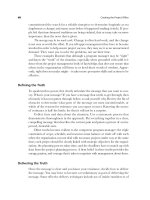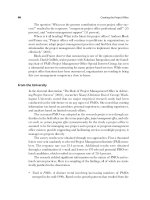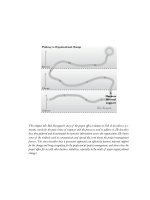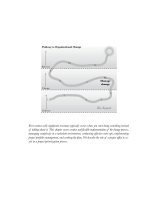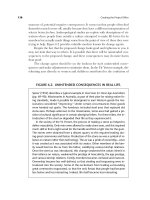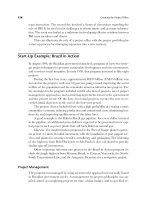Creating the project office 11
Bạn đang xem bản rút gọn của tài liệu. Xem và tải ngay bản đầy đủ của tài liệu tại đây (157.35 KB, 10 trang )
and suggestions. Write down their objections—these are gifts: the clues they offer
about what you need to do to elicit their support. Follow through with changes.
Get explicit commitments from everyone involved with the program—people are
more inclined to do something once they commit to do so.
Assume everyone who needs to be influenced is a potential ally or can be-
come one. Determine their goals, style, and needs. Imagine yourself in their po-
sition. Many interpersonal currencies can be exchanged, based on people’s needs:
exposure to new technology, information, response time, recognition, gratitude,
resources. Diagnose your relationship using the stakeholder map and plan an ap-
proach tailored to each person’s concerns.
Get all participants together face-to-face when beginning the program. De-
velop relationships and trust by doing team-building exercises. When reasons for
the cross-organizational program are explained and concerns shared, participants
come to accept one another and validate their roles. Recognize differences and
seek consensus on values. A shared vision provides the intellectual cohesion that
keeps cross-organizational partners focused.
Align priorities and establish a decision priority list based on the relative im-
portance of schedule, scope, and resources. Define a process to raise and resolve
issues quickly, including an escalation path. Separate technical from organizational
issues; keep engineers working on technical issues and escalate organizational or
business issues to a business or program team that will make the tough decisions.
Empower decision making at the lowest reasonable level. Let everybody know
how decisions are made. Document assumptions. Set up a specification change
management process that not only helps to sustain decisions and foster stability
but also permits flexibility.
Develop working goals and due dates. Because fuzzy goals become even
fuzzier over distance, document specific goals for each partner that are clear, vis-
ible, and understood by everyone. Reduce interdependencies as much as possible.
Document interface definitions and agreements that match deliverables with de-
pendencies. Structure work so teams operate separately but in unison. Get con-
spicuous buy-in for accountability and results.
Maintain Relationships
Be aware that weak relationships are a dominant failure factor when operating
across organizations. Trust is the foundation for effective teamwork. Maintain an
open environment. Express genuine interest in other people and what is happen-
ing in their organizations. Be visible, approachable, positive, and supportive. Avoid
favoritism. Regularly assess morale and relationships via two-way communica-
tions. Add a personal touch to communications. Be authentic and maintain in-
tegrity in all dealings.
78 Creating the Project Office
Having good plans, especially current and realistic schedules and thorough
communications, may reduce conflicts. Nurture constructive tension. Focus en-
ergy on common objectives. Make decisions based on objective criteria.
Be the leader who facilitates communications. Do this by designing easier and
more effective ways to meet information needs of all stakeholders. Meet regularly
with teams and individuals (also rotate the site) to keep focused and track progress.
Be effective in managing meetings. Publish decisions and action items. Keep ob-
jectives visible in summary reports and distribute them widely. Get updated pro-
gram documents to all sites or use a Web-based information system. Remote team
members thrive on information about the program and a connection with the
team. Even though travel budgets are usually tight, there is no substitute for meet-
ing face-to-face at least once a year to prevent or resolve major differences and to
celebrate milestones and other successes.
Adapt to Changes
Quickly respond to changes or variances. Rebuild teamwork by training new peo-
ple together with people who need a refresher. Conduct just-in-time training when
new challenges arise.
Approach other organizations with an attitude that no one site necessarily has
the right answer. It is good management to adopt successful informal practices
into formal procedures. Be sensitive to the ebb and flow of group dynamics; back
off when the natural energy of the team is at work, and push back when they go
off on tangents. By being flexible, by learning and adapting to situations as they
arise, and by working to have decisions turn out right, you may exercise more in-
fluence and achieve greater success than by trying to drive people rigidly.
Involve the complete team and make corrections based on project reviews.
Capture information from persons leaving the program. Document their exper-
tise and processes so transitions are smooth.
Upon completion of the program, conduct similar celebrations at each remote
site. When relationships change, express appreciation for the opportunity to work
together toward a common goal and for the cooperation displayed during the pro-
gram. Each program and each relationship should have a clear closure. No matter
how problematic any relationship has been, try not to burn the bridges behind you
when you part company—you may well have to work together again in the future.
Summary
Recognize that organizations are political. A commitment to positive politics is an
essential attitude that creates a healthy, functional organization. Create relation-
ships that are win-win (all parties gain), actual intentions are out in the open (not
Powerful Forces 79
hidden or distorted), and trust is the basis for ethical transactions. Determining
what people want and need and providing value to recipients are currencies of
exchange. Increased influence comes from forming clear, convincing, and com-
pelling arguments and communicating them through all appropriate means. Ef-
fective program managers embrace the notion that they are salespersons,
politicians, and negotiators. Take the time to learn the skills of these professions
and apply them daily.
Position the project office within the power base of the organization. There
is no one right answer to where the PO should report. Seek an energetic, enthu-
siastic, politically effective sponsor and stakeholder to champion and support the
effort.
Conduct a stakeholder analysis to determine supporters and resistors. Ap-
proach them differently based on the results of that analysis.
Returning to the question about getting people to work with you, you can
bring people on board by showing them that the program provides means to meet
organizational needs; participants have more fun; the experience is stimulating;
you help them more than others; they get constructive feedback; they are excited
by the vision; they learn more from you and this program; their professional needs
are met; they travel and meet people; it’s good for their careers; together we’ll ac-
complish more than separately; this is neat....
This chapter covers several techniques for building a guiding coalition. The
extent that these powerful organizational forces are on board (or not) now enables
you to go ahead in a big way, modify or downscale the effort, or quit and move
on to something easier.
The complete successful change agent
• Becomes politically sensitive
• Identifies the sources and roles of power in the organization
• Recruits an executive sponsor
• Senses behavioral patterns and develops skills to address them
• Develops a political plan
• Manages all stakeholders
• Effectively speaks truth to power
• Applies a systematic process to operate across organizations
80 Creating the Project Office
This chapter describes the formulation of a project office and provides input for the change agents
tasked with implementing one, especially when managing multiple projects is at issue. The re-
sponsibility of a change agent includes forming a detailed statement about what will be different
in the organization and what it will look like. This chapter provides a range of alternatives and
trade-offs to select from. It also offers a framework of process steps and questions to answer as
a guideline for designing the best organizational approach and selecting the appropriate scope for
the context of the existing organization.
The purpose of this chapter is to help potential change agents focus on a vision to be achieved,
select an appropriate structure, and begin communicating a strategy to achieve the vision.
1.
3.
4.
Vision and strategy
5.
6.
7.
8.
9.
10.
11.
Refreeze
Change
Unfreeze
2.
Pathway to Organizational Change
